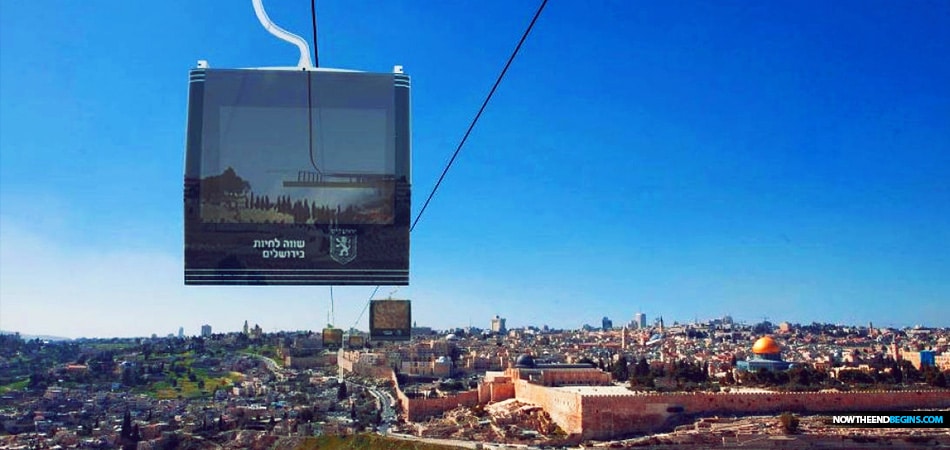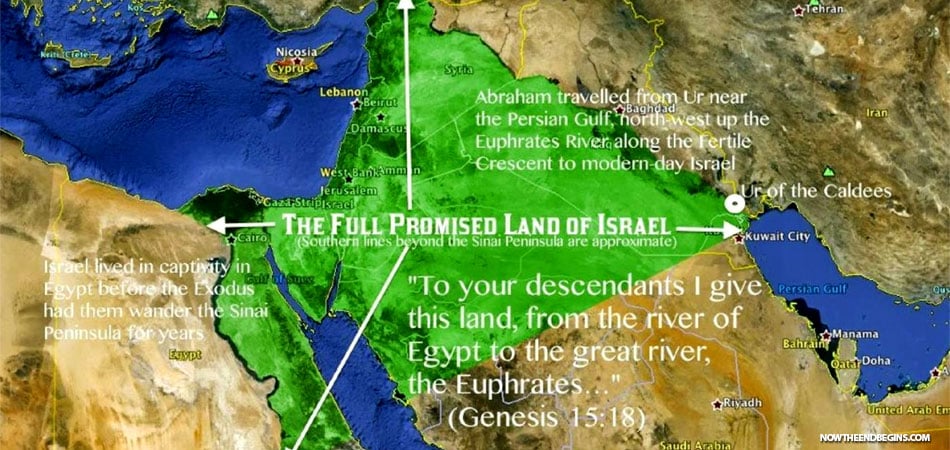
From Mount Zion, the cable cars will land near the Western Wall, on the rooftop of what is to be a new multistory center for a right-wing Jewish settler organization called the City of David Foundation, in the midst of a Palestinian district of East Jerusalem called Silwan.
The approved plan to build a network of cable cars to fly over the Holy City of Jerusalem and surrounding areas is indeed an intriguing idea. On one hand, I can certainly understand the position of the historical preservationists and
biblical archaeologists who largely are against this plan. But as someone who studies the Bible, loves Israel and its amazing history, the chance to fly closely above the Temple Mount is something I would absolutely want to do.
"Beautiful for situation, the joy of the whole earth, is mount Zion, on the sides of the north, the city of the great King." Psalm 48:2 (KJV)
In the story below, originally published in the New York Times, they take the position that building the cable cars will only serve to "promote Jewish associations with the land", and somehow because of that the cars are seen as a bad thing? Someone should tell the haters over at fake news NYT, liberal publishers of
anti-semitic cartoons, that Israel,
all of Israel belongs to the Jewish people now and for all eternity. And if they want to put cable cars over the world's most famous city, that is their city to begin with, then I say mazel tov!
Cable Cars Over Jerusalem? Some See ‘Disneyfication’ of Holy City
FROM MSN: At a glance, Jerusalem’s Holy Basin still looks pretty much as it must have looked centuries ago. The Old City’s yellow walls still read in silhouette against an ancient landscape of parched hills and valleys. The skyline is still dominated by the city’s great Muslim and Christian shrines: the gold, glistening Dome of the Rock and the Church of the Holy Sepulcher, where Jesus was said to have been buried.
But this is about to change. Israeli authorities have approved a plan to build a cable car to the Western Wall, the holiest site in the Jewish world, by 2021. It’s the first phase of what Nir Barkat, Jerusalem’s former mayor and now a Likud member of Parliament, describes as a long-term vision to install a fleet of cable cars crisscrossing the basin.
Trumpeted by right-wing Israeli leaders as a green solution to the challenges of increased tourism and traffic in and around the Old City, the plan has provoked howls of protest from horrified Israeli preservationists, environmentalists, planners, architects and others who picture an ancient global heritage site turned into a Jewish-themed Epcot, with thousands of passengers an hour crammed into huge gondolas lofting across the sky.
“A total outrage against a fragile city,” the Israeli architect Moshe Safdie says. “An aesthetic and architectural affront.”
On Tuesday, Prime Minister Benjamin Netanyahu, battling to win re-election, vowed that if he returned to office
he would annex nearly a third of the occupied West Bank, reducing any future Palestinian state to an encircled enclave. Israeli critics dismissed the announcement as a last-minute election ploy, but it was in keeping with land-use policies by which Israel, for half a century, has devised an elaborate architecture of occupation.
The cable-car project is an example, illustrating how Israel wields architecture and urban planning to extend its authority in the occupied territories. Whatever its transit merits, which critics say are negligible, the cable car curates a specifically Jewish narrative of Jerusalem, furthering Israeli claims over Arab parts of the city.
It also shows how Israel’s current government seems to hold preservation less sacrosanct than previous ones — eroding, for political purposes, the protections on landscape and heritage that make this city a global icon of faith and history, much as the Trump administration in the United States has been loosening protections for national monuments and endangered species.
The plan is basically this: Suspended from giant pylons, entered via elevated, glass-enclosed stations, the cable cars will swoop down from a Jewish neighborhood in the western part of Jerusalem to Mount Zion. They will skirt, where possible, Jewish grave sites in acknowledgment of biblical prohibitions about passing over cemeteries.
From Mount Zion, the cars will land near the Western Wall, on the rooftop of what is to be a new multistory center for a right-wing Jewish settler organization called the City of David Foundation, in the midst of a Palestinian district of East Jerusalem called Silwan. The City of David oversees archaeological excavations centered on uncovering biblical Jewish remains in an effort to cement an ancient Jewish connection to a contested site. Israel considers East Jerusalem annexed, but international law considers it occupied territory.

The Cable Car to Jerusalem’s Old City: Who Gains and Who Loses?
For years, the foundation has also been trying to drive Palestinians out of the neighborhood and move settlers in. Archaeology works hand in glove here with settler efforts to press Jewish claims on the land. Cable car passengers will be funneled through a Jewish version of the city’s history. After disembarking at the City of David, they can tour the archaeological site, then proceed underground to the Western Wall via Herodian passageways walked by Jewish pilgrims during the era of the Second Temple and now partly excavated beneath the homes of Palestinian families in Silwan.
Notwithstanding that several Arab homes may be demolished to make room for it, in effect the cable car pretends Arab Silwan isn’t there. Tourists will fly over and tunnel under Silwan’s Palestinian residents without actually having to encounter them.
The plan can bring to mind Israel’s so-called bypass roads, built to safely speed Jewish settlers in the occupied West Bank to Jerusalem without passing through Palestinian towns.
“Arabs will supposedly benefit from using the cable car,” says Jawad Siyam, a Silwan resident whose family members were recently evicted from part of their home to make way for City of David settlers. “But the cable car is not about solving problems for us. It’s about creating them.”
Mr. Siyam maintains that if Israeli authorities really want to benefit Arab residents, they should repair the busy, rutted, narrow, dangerous, often impassable road that is the only way in or out of Silwan for thousands of Palestinian residents.
“Silwan is huge and hilly,” he adds. “Most of us don’t even have an easy way to get to the cable car.”
Cable car advocates dismiss the criticism. Jerusalem is “far behind other places in terms of public transport,” Mr. Barkat argues. This plan involves “thinking out of the box.”
He describes a kind of Jetsons-like future Holy Basin in which cable cars will eventually glide up to the Mount of Olives, down to the Garden of Gethsemane, and make a second stop in Silwan, beside the excavated remains of what City of David officials say is the Pool of Siloam, where ancient Jewish pilgrims cleansed themselves before ascending the Temple Mount.
Yes, Mr. Barkat acknowledged, the plan also promotes the City of David.
“This is the Zionist element of the project,” he said. “The City of David is the ultimate proof of our ownership of this land.” To go from there to the Western Wall is to follow “the path where Jewish pilgrims came to worship God in the ancient city,” the former mayor pointed out, when “there were no Christians or Muslims.”
He predicts the gondolas and cable car stations will be less of an intrusion on the skyline than critics fear. “It’s a matter of taste and perception,” he says. The architect for the stations, Mendy Rosenfeld, agrees. He has devised the glass designs to appear as immaterial as possible. “There is no way you can hide a cable car system,” he admitted.
But Mr. Rosenfeld cites I.M. Pei’s pyramid at the Louvre, a modernist glass interloper in the historic courtyard of France’s former royal palace. Skeptics attacked the pyramid before it opened.
“Now everyone loves it,” Mr. Rosenfeld said. But Jerusalem is not Paris.
Having worked as an architect and planner on projects in the Holy Basin over many years, Gavriel Kertez recalls how Israeli officials used to be “enormously sensitive to any tiny intrusion on this sacred place.”
In a city long defined by low-rise, stone-clad buildings, Israeli authorities are now approving 40-story glass towers and cut-and-paste office park development more in keeping with Singapore or Jakarta than Jerusalem.
“Apparently a forest of huge pylons and high-rise cable car station on Mount Zion is O.K., too,” Mr. Kertesz laments.
It has not been lost on Arab residents that the government chose Jerusalem Day last year to announce a budget plan for the cable car. Jerusalem Day commemorates Israel’s capture of East Jerusalem during the Six Day War of 1967.
Since then, Israel has been strategically redrawing borders and constructing roads, walls and massive Jewish settlements to safeguard Jews but also to take over, divide, cordon off and limit the expansion of Arab neighborhoods.
This Is How Much Land Israel Will Have In The Millennial Kingdom Of King Jesus
The tiny, little fraction of Israel proper that the Jews have at the present moment pales in comparison with how much God says they really have. The day is coming when they will finally receive the full amount. This will take place during the
Millennial Reign of Jesus the Messiah that happens right after the
Battle of Armageddon.

WHO’S OCCUPYING WHO? LET’S LOOK AT GOD’S ORIGINAL LAND GRANT OF THE NATION OF ISRAEL TO ABRAHAM
Even the cladding of East Jerusalem’s settlements in Jerusalem stone, the architectural uniform traditionally worn by buildings in Jewish West Jerusalem, helps spread the image of a single Jewish city. The cable car, critics say, is part of this same effort to inculcate a Jewish narrative of occupied Jerusalem. “More than demography,” says Ronnie Ellenblum, a sociology professor and historical geographer at Hebrew University, “this is the true battlefront for control of the city.”
Mr. Ellenblum contrasts the cable car’s architectural effect — “straight, inflexible, indoctrinating” — with the Old City’s maze of Christian, Jewish and Muslim quarters, requiring “that you pass through all sorts of places before you reach your destination, mingling, feeling lost, ultimately finding yourself.”
“The Old City is ecumenical, uncontrollable, multicultural public space,” he said. “It is historical Jerusalem. The cable car, with its Disneyfication of the city, expresses the failure of Israel today to dominate this public realm.” Modern Jerusalem was spared Disneyfication, first by the highborn culture of British colonialism, with its awe for the city’s antique past, and next by Jordanian paralysis, which froze the Old City as if in amber.
Then after 1967, Teddy Kollek, Jerusalem’s mayor, while no hero to Palestinians, promoted the notion of a global melting pot, greater than any single narrative or religion. His cosmopolitan attitude reflected a posture of Israeli confidence, according to Mr. Safdie, the architect.
After 1967, Mr. Safdie worked on various projects in the Old City, including around the Western Wall, onto which he now looks down from his home. The Western Wall is “a ruin, humble, an ancient site of sadness and loss,” he says. “It is the true heart of Judaism. The cable car is the opposite, flashy, vulgar and aggressive.”
It symbolizes a blustery kind of inward-turning. “Its aggression suggests not strength,” is how Mr. Safdie puts it, “but insecurity and weakness.”
READ MORE
No comments:
Post a Comment